Introduction to Graphs - PowerPoint PPT Presentation
Title:
Introduction to Graphs
Description:
Introduction to Graphs What is a Graph? Some Example applications of Graphs. Graph Terminologies. Representation of Graphs. Adjacency Matrix. Adjacency Lists. – PowerPoint PPT presentation
Number of Views:312
Avg rating:3.0/5.0
Title: Introduction to Graphs
1
Introduction to Graphs
- What is a Graph?
- Some Example applications of Graphs.
- Graph Terminologies.
- Representation of Graphs.
- Adjacency Matrix.
- Adjacency Lists.
- Simple Lists
- Review Questions.
2
What is a Graph?
- Graphs are Generalization of Trees.
- A simple graph G (V, E) consists of a non-empty
set V, whose members are called the vertices of
G, and a set E of pairs of distinct vertices
from V, called the edges of G.
Undirected
Directed (Digraph)
Weighted
3
Some Example Applications of Graph
- Finding the least congested route between two
phones, given connections between switching
stations. - Determining if there is a way to get from one
page to another, just by following links. - Finding the shortest path from one city to
another. - As a traveling sales-person, finding the cheapest
path that passes through all the cities that the
sales person must visit. - Determining an ordering of courses so that
prerequisite courses are always taken first.
4
Graphs Terminologies
- Adjacent Vertices there is a connecting edge.
- A Path A sequence of adjacent vertices.
- A Cycle A path in which the last and first
vertices are adjacent. - Connected graph There is a path from any vertex
to every other vertex.
Path
Cycle
Connected
Disconnected
5
More Graph Terminologies
- Path and cycles in a digraph must move in the
direction specified by the arrow. - Connectedness in a digraph strong and weak.
- Strongly Connected If connected as a digraph -
following the arrows. - Weakly connected If the underlying undirected
graph is connected (i.e. ignoring the arrows).
Directed Cycle
Strongly Connected
Weakly Connected
6
Further Graph Terminologies
- Emanate an edge e (v, w) is said to emanate
from v. - A(v) denotes the set of all edges emanating from
v. - Incident an edge e (v, w) is said to be
incident to w. - I(w) denote the set of all edges incident to w.
- Out-degree number of edges emanating from v --
A(v) - In-degree number of edges incident to w --
I(w).
Directed Graph
Undirected Graph
7
Graph Representations
- For vertices
- an array or a linked list can be used
- For edges
- Adjacency Matrix (Two-dimensional array)
- Adjacency List (One-dimensional array of linked
lists) - Linked List (one list only)
8
Adjacency Matrix Representation
- Adjacency Matrix uses a 2-D array of dimension
VxV for edges. (For vertices, a 1-D array is
used) - The presence or absence of an edge, (v, w) is
indicated by the entry in row v, column w of the
matrix. - For an unweighted graph, boolean values could be
used. - For a weighted graph, the actual weights are used.
9
Notes on Adjacency Matrix
- For undirected graph, the adjacency matrix is
always symmetric. - In a Simple Graph, all diagonal elements are zero
(i.e. no edge from a vertex to itself). - The space requirement of adjacency matrix is
O(n2) - most of it wasted for a graph with few
edges. - However, entries in the matrix can be accessed
directly.
10
Adjacency List Representation
- This involves representing the set of vertices
adjacent to each vertex as a list. Thus,
generating a set of lists. - This can be implemented in different ways.
- Our representation
- Vertices as a one dimensional array
- Edges as an array of linked list (the emanating
edges of vertex 1 will be in the list of the
first element, and so on,
vertices
edges
1
2
3
4
?
?
?
?
? 1,2
? 1,3
Null
? 2,3
? 2,4
Null
Empty
? 4,1
? 4,3
? 4,2
Null
11
Simple List Representation
- Vertices are represented as a 1-D array or a
linked list - Edges are represented as one linked list
- Each edge contains the information about its two
vertices
vertices
edges
edge(1,2)
edge(1,3)
edge(2,3)
edge(2,4)
edge(4,1)
edge(4,2)
edge(4,3)
1
2
3
4
. . .
. . .
12
Review Questions
- Consider the undirected graph GA shown above.
List the elements of V and E. Then, for each
vertex v in V, do the following - Compute the in-degree of v
- Compute the out-degree of v
- List the elements of A(v)
- List the elements of I(v).
- Consider the undirected graph GA shown above.
- Show how the graph is represented using adjacency
matrix. - Show how the graph is represented using adjacency
lists. - Repeat Exercises 1 and 2 for the directed graph
GB shown above.































